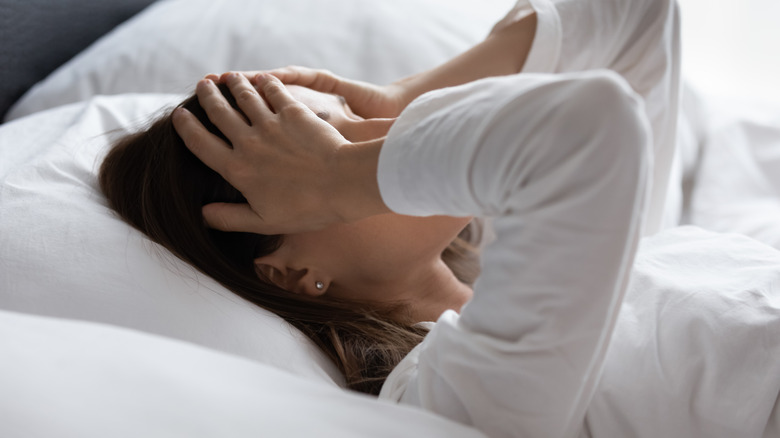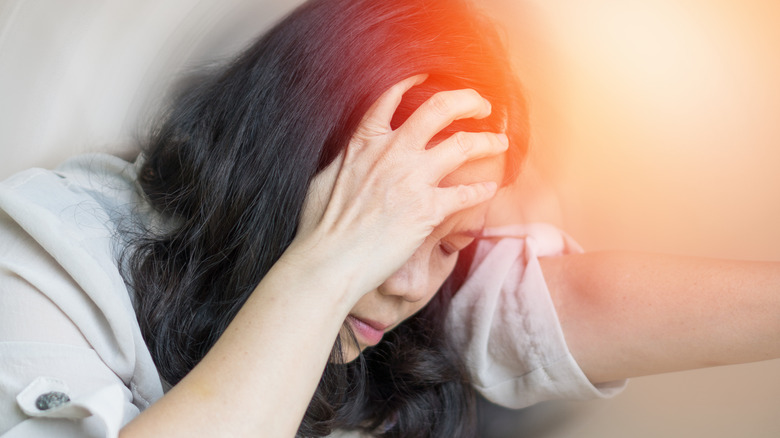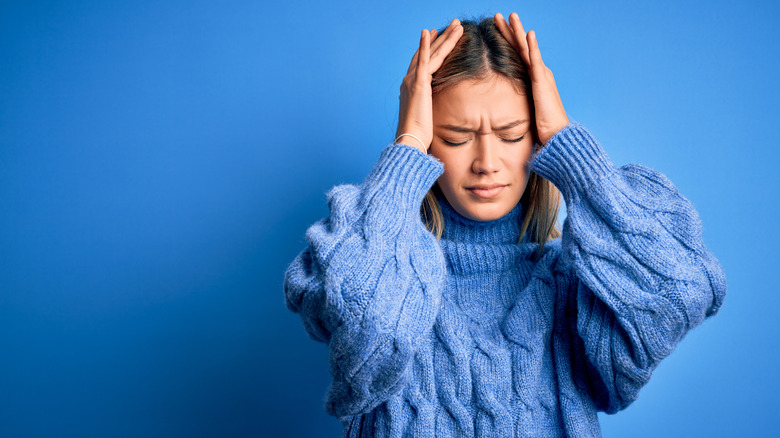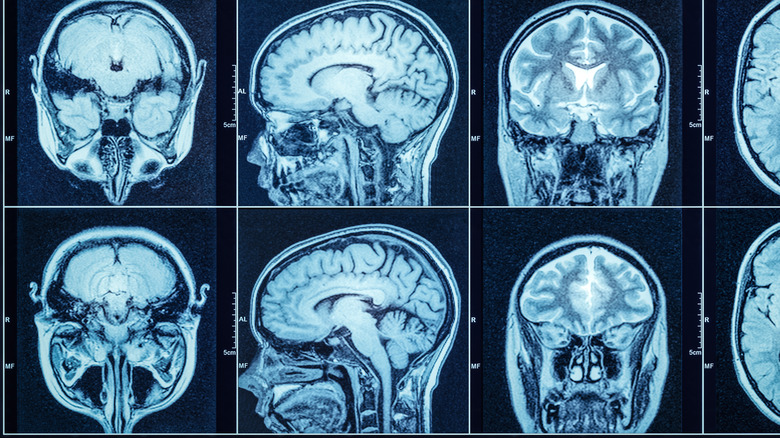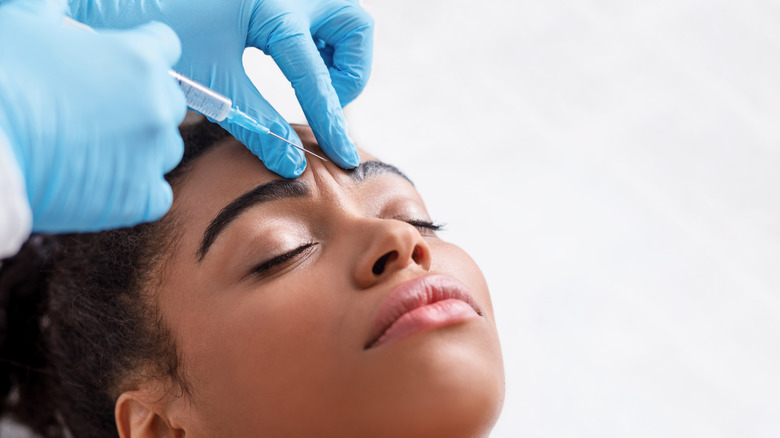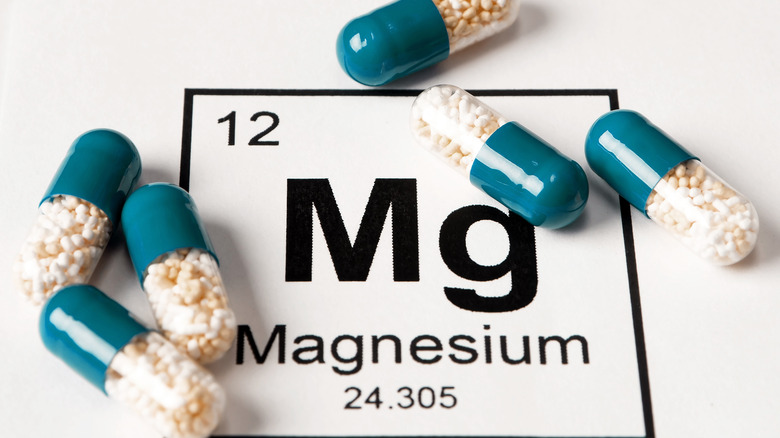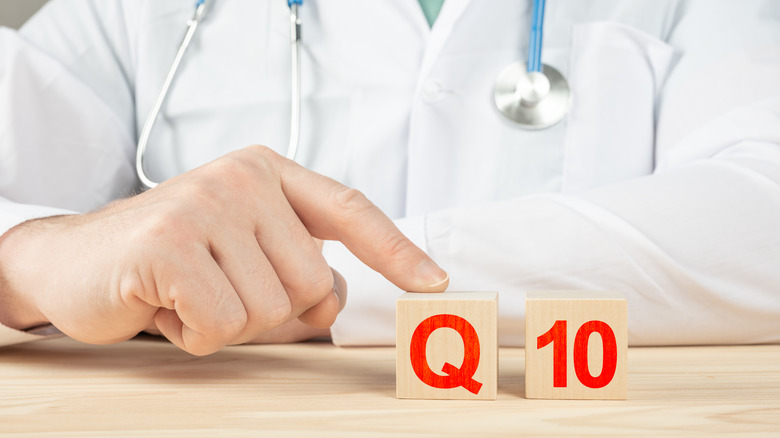Migraines Explained: Causes, Symptoms, And Treatments
Much worse than your average headache, a migraine is a neurological condition that causes severe head pain, often accompanied by sensitivity to light, nausea, and vomiting. These "attacks" can last for days and occur several times a month. According to the Cleveland Clinic, an estimated 12% of Americans suffer from migraines, which are considered to be the "sixth most disabling disease in the world." Sadly, almost nine out of ten migraineurs are not able to live their normal life, including work, during a migraine episode (via the Migraine Research Foundation).
According to Johns Hopkins, deficiencies or fluctuations of the hormones serotonin and estrogen play an important role in migraines. As explained in a study published in Current Opinion in Neurology in 2014, although the mechanism isn't completely understood, drops or changes in estrogen levels appear to increase the risk of migraine in various ways. This may be why headaches in general, and migraines in particular, are especially common in premenopausal women. Indeed, migraines are two to three times more common in women compared to men. On the other hand, serotonin is an important consideration for both men and women who are trying to understand the cause of their painful migraine attacks. Serotonin regulates how nerve cells communicate with one another, and it can cause blood vessels to narrow (per Johns Hopkins). When serotonin levels fluctuate, a migraine can result (via Science).
Prodromes and auras
Some migraineurs, but certainly not all, experience prodromes and auras before a migraine attack (via Mayo Clinic). A prodrome is a kind of warning bell that rings before an illness occurs — the early symptoms that signify a larger problem is coming (via Merriam Webster). The prodrome phase of a migraine can be pretty easy to ignore for a lot of people — nonspecific things like constipation, food cravings, fluid retention, and increased urination are pretty typical for many of us. However, migraine sufferers who are in tune with their body might be able to notice changes like these one or two days before the onset of migraine.
Auras, on the other hand, can occur right before a migraine, or even simultaneously (via familydoctor.org), occurring in between the prodrome and the beginning of the migraine attack. Symptoms often include vision changes, such as temporary vision loss or seeing flashes of light. Other people report experiencing tingling in the limbs and difficulty speaking. All of these symptoms can be terrifying and sometimes mimic a stroke or other medical emergency.
Migraine attacks
According to WebMD, migraine attacks escalate from a milder to a more intense pain, and typically last anywhere from four hours to several days depending on the person. Each person will experience the pain differently — for some, it will be focused on one side of the head or the front of the head, but others will experience discomfort in their entire head. Approximately 80% of people experience nausea, and about half will vomit during an attack. Still others feel weak and clammy, or experience loss of appetite, pale skin color, dizziness, or a tender scalp. Rarely migraines are accompanied by diarrhea or a fever. The majority of people get two to four migraines a month, but again, this varies widely.
Some people also experience mood changes including giddiness, anxiety, and depression throughout their migraine (via the American Migraine Foundation). As you would expect, trouble sleeping is also common during a headache of this magnitude.
The postdrome period
The postdrome period is sometimes referred to as a "migraine hangover" (via the American Migraine Foundation). During this time, migraineurs might experience stiffness and pain in the neck and shoulders, a delicate-to-the-touch scalp, and dizziness. Maintaining adequate hydration and doing light activity when possible during the attack may stave off postdrome symptoms. Afterward, utilizing ice or heat can help to lessen the discomfort. Some people experiment with caffeine and find that it helps, while others quickly discover that it hinders their recovery progress. Rest is also important for recuperation.
In one small study of 120 patients published in Neurology, 81% experienced a postdrome symptom other than headache. Most often, the main complaint during this period was feeling tired or weary. However, most patients felt normal within 24 hours of the headache ending. Interestingly, the severity of the migraine was unrelated to how long the postdrome period lasted.
Migraine risk factors
The Migraine Research Foundation reports that 90% of migraine sufferers have a family history of migraines, and that 85% of migraine sufferers are women. As difficult as migraines can be for adults, about 10% of school-age children also deal with them, as well as nearly 30% of adolescents (ages 15-19).
Migraines occur more often in people with certain conditions including some mental health problems such as depression, bipolar disorder, sleep disorders, obsessive-compulsive disorder, and anxiety (via Medical News Today). It also occurs more frequently in those diagnosed with fibromyalgia, irritable bowel syndrome, and overactive bladder. After head trauma, some people — even those without a personal or family history of headaches — develop frequent and severe "migraine-like headaches." Some research has also linked childhood abuse with an increased risk of migraines in adulthood (via Everyday Health), though one study published in Headache suggests that emotional abuse is more likely to be correlated with this neurological condition than either physical or sexual abuse.
Migraine diagnosis
Unfortunately, there is no definitive test that can be used to diagnose migraines (via Healthline). Therefore, many physicians ask their patients to keep a detailed record of their symptoms, diet, sleep, activity level, and other lifestyle factors that could influence their attacks. It's also critically important to keep a diary of the medications that you take. Finding a pattern is key to diagnosing and treating these painful attacks. You will most likely be diagnosed with migraines if you've had "at least five headaches that have lasted between four and 72 hours."
Occasionally, the doctor might order imaging to rule out other causes for your pain, such as aneurysms or tumors. WebMD adds that besides imaging of the head or brain, some doctors will order blood chemistry, urinalysis, sinus x-rays, EEG (if seizures are suspected), an eye exam, or a spinal tap (to rule out infection). The symptoms that come along with your headache, including light sensitivity or nausea, are important for the doctor to know about so be sure to be mindful of what you're experiencing and keep detailed notes.
Migraine triggers
Triggers for migraines are unique to each person. While one person might be most at risk for an attack during periods of stress or when they feel anxious, another might be more prone to migraine when they come in contact with stimuli such as bright or flashing lights, loud noises, strong smells such as perfume, or even changes in the weather or environment (via MedlinePlus). For women, hormonal changes can be a trigger.
Caffeine and alcohol are also common triggers. For instance, one small study published in the American Journal of Medicine found a link between high caffeine consumption and likelihood of a migraine. That said, going cold turkey may not be a cure-all, as caffeine withdrawal is also a recognized trigger (per MedlinePlus). Additionally, one-third of migraineurs report that alcohol triggers their attacks (via Harvard Health Publishing). However, the type of alcohol that causes headaches the most often is a subject of much debate, so it's best to listen to your body.
Finally, overuse of pain medication can itself trigger headaches and migraines, and it's understandable how this seemingly endless cycle of pain and medication use occurs (via American Migraine Foundation). Once a trigger has been identified, avoiding it may help a migraineur to stave off future attacks (via MedlinePlus).
Diet for migraines
For some people, dietary factors play a key role in migraine prevention. Skipping meals or letting yourself become dehydrated can trigger attacks, especially when combined with lack of sleep or overexertion (via MedlinePlus). As mentioned previously, alcohol and caffeine are triggers for many migraineurs. Tyramine — an amino acid found in aged cheese, chocolate, some plant-based foods and nuts, fermented or pickled foods, yeast, and cured or processed foods — are also on the do-not-eat list for some people. To limit intake of tyramine, the National Headache Foundation lists vegetables to be avoided as snow peas, fava or broad beans, sauerkraut, pickles, and olives. They recommend limiting raw onion. No fruit needs to be avoided completely, but they do recommend limiting the following: citrus fruits, avocado, banana, figs, raisins, dried fruit, papaya, passion fruit, and red plums.
Other than these foods, according to a review published in Nutrients, research has shown that some people with migraines fare better if they avoid foods containing monosodium glutamate (MSG), nitrites, aspartame, sucralose (a sugar alcohol used in sugar-free and reduced-sugar foods), and the gluten found in wheat, rye, oats, and barley. For this reason, minimizing processed foods as much as possible could be helpful to many people hoping to prevent a debilitating migraine attack.
Complications from migraines
Most migraines resolve without any health complications. However, two possible complications worth mentioning include status migrainosus and migrainous stroke. Although quite rare, you should be aware of the symptoms of both and know when to seek medical attention. Status migrainosus is a migraine that lasts beyond the expected four to 72 hours (via WebMD). Treatment might involve a hospital stay to get your pain and nausea under control enough that you can sleep and efforts can be made to rehydrate you. This complication is most often a result of taking too much headache medication. More seriously, The Migraine Institute clarifies that status migrainosus can lead to "stroke, aneurysm, permanent vision loss, serious dental problems, coma, and even death."
Very rarely, a migraine might lead to migrainous stroke, which occurs when oxygen supply to the brain is cut off by narrowed blood vessels. This is a medical emergency requiring immediate treatment. Sufferers always experience an aura, but may have other symptoms of migraine and stroke including vision problems (sensitivity, blurriness, blind spots), exhaustion, sudden onset of dizziness or lack of coordination, and acute numbness or weakness, particularly if it only affects one side of the body (via Cedars-Sinai). Per WebMD, migrainous infarctions most often occur in females below the age of 45 who both smoke and take birth control. A stroke will be visualized via an MRI or CT scan, and other potential causes of stroke must be ruled out before it is diagnosed as migrainous (via Verywell Health).
If you experience migraines, it's also important to pay special attention to your emotional well being. Migraineurs are roughly five times more likely to experience depression than other people (via the American Migraine Foundation). Meanwhile, roughly 20% of individuals with episodic migraines report anxiety, while 30-50% of those with chronic migraines also have anxiety.
Oral medications for migraines
A variety of oral medications are used to both treat and prevent migraine attacks (via American Migraine Foundation). For example, triptans target serotonin receptors on certain nerves and blood vessels to stop the triggering of pain pathways. A similar medication, ergotamines, constricts blood vessels to control the swelling and subsequent nerve impingement that set off a cascade of migraine symptoms.
Two newer types of treatment, ditans and gepants, are taken at the beginning of an attack to target specific nerves that cause symptoms of migraines, such as sensitivity to light and nausea. While ditans are a controlled substance and can't be used if you will be driving or operating other machinery in the eight hours after taking them, they are often preferred for older patients or those with vascular problems because, unlike triptans, they don't cause blood vessels to narrow (which, for those at risk, can increase their chance of stroke or heart attack).
Several types of medication traditionally used to treat high blood pressure have proven effective for treating migraines, including ACE inhibitors, angiotensin II receptor antagonists (ARBs), beta-blockers, and calcium channel blockers. Antidepressants and anti-seizure medications are also used as preventative medicines. Another option is antihistamines, which halt histamine-related inflammation, and have proven helpful for many people.
Botox and neuromodulation for migraines
Botox injections are FDA-approved for the treatment of chronic migraines (via Healthline). The toxin is injected into the forehead or neck muscles, around the pain fibers that trigger headaches, every three months (via Healthline). The American Migraine Foundation asserts that Botox is used for people who experience at least 15 or more headache days each month. After treatments, headache days are typically cut in half. A Greater Occipital Nerve (GON) block injection contains anesthetic and steroids and are administered in the area of the greater occipital nerve (via The Migraine Trust). Roughly two of three people report improvement following GON block injection.
If you prefer to avoid pills and injections, migraines can also be managed or prevented with neuromodulation devices (via Verywell Health). These devices — which incorporate magnets and electrodes — use electricity to stimulate nerves, block pain signals, or interrupt the electrical activity in the brain that causes migraine symptoms. Some of them can even pair with your smartphone to make the treatment more portable and appealing to younger migraineurs.
Magnesium treatment
According to a research reviewed in Magnesium in the Central Nervous System, magnesium is considered to be a potential treatment for headaches, including migraines. Some, but not all, patients with migraines have low magnesium levels in their blood, cerebrospinal fluid, and brain tissue. A small study of 40 patients having migraine attacks found that half of them had deficient blood levels of ionized magnesium. When magnesium sulfate was given intravenously (IV) to the patients with deficiency, 86% reported pain relief that lasted longer than a day. However, only 16% of patients with normal levels of ionized magnesium reported symptom improvement after the IV. In another randomized trial on 30 patients, of those given magnesium sulphate via IV, 100% experienced a positive response (versus only 7% of the placebo group) and 87% were pain-free (versus 0% of the placebo group). Those who were treated also remained headache free for the next 24 hours. However, 87% of the participants receiving the magnesium complained of a "burning sensation in the face and neck."
In a double-blind study on 24 women with hormone-related migraines, those given oral magnesium supplements every day from ovulation to menstruation experienced "significant reduction" in days of headache, total pain index, and score improvement on the Menstrual Distress Questionnaire. Other studies have also demonstrated improvement in migraine frequency and severity, as well as positive changes visible on brain imaging. Still, not all studies have been consistent in showing benefit. In terms of side effects of magnesium treatments, most otherwise healthy people won't experience any besides possible diarrhea.
Supplements for migraines
According to the National Institutes of Health (NIH), although some research has found that feverfew — a plant that has been used for various medicinal purposes since ancient times (per Pharmacognosy Review) — could possibly help to prevent migraines, evidence is scant and not all studies show benefit. Feverfew can cause some unpleasant digestive side effects, though, and people who are allergic to ragweed should be cautious when taking feverfew.
The shrub butterbur has also been used to treat and prevent migraines (via NIH). Unfortunately, butterbur can cause some serious side effects due to its content of pyrrolizidine alkaloids (PA), a toxin that can cause liver failure and has been linked to cancer as well (via Science Direct). And though there are some butterbur products that purport to be PA-free, some experts recommend that butterbur be avoided entirely, since even those labeled as PA-free may still contain trace amounts.
FInally, a meta-anaylsis published in BMJ Open in 2021 determined that coenzyme Q10 (CoQ10) could help diminish both the length and number of migraine attacks. However, there was no effect on migraine severity at any dosage. There was also some evidence that nausea may improve with CoQ10 administration, but this wasn't conclusive. As always, be sure to consult your medical professional before adding any supplement to your routine, and also to tell them about any supplements you're currently taking — this will help you to avoid drug interactions and unintended side effects (via Drugs).
Silent migraines
Some people are surprised to learn that there is such a thing as migraines without head pain. According to the Cleveland Clinic, silent migraines, also called ocular or ophthalmic migraines, cause vision issues such as the flashes of light, seeing double, or blind spots that are associated with auras. Despite not being painful, these migraines can still get in the way of daily life by interfering so significantly with the sufferer's ability to see (via Verywell Health). However, opthalmic migraines tend to resolve more quickly than regular migraines — symptoms typically last 20-30 minutes, and rarely longer than an hour – and they do not as frequently cause sensitivity to stimuli like sounds or odors. Magnesium supplements might help to treat silent migraines. Other strategies for treatment and prevention of silent migraines are the same as for standard migraines, and they are diagnosed using the same methods — though diagnosis can be difficult given the absence of the key symptom of typical migraines: pain. For this reason, sometimes silent migraines are mistaken for other conditions like epilepsy that also include vision changes or an aura among their symptoms (via Healthline).
Outlook for those with migraines
The good news is that treatment options for migraines continue to evolve (via WebMD). As researchers unravel what causes migraines, more opportunities to prevent them from occurring in the first place will become readily available. New drugs and delivery methods for existing medications, such as nasal sprays and injections, have made treatment easier and more effective.
For some people, migraines improve over time, either as a result of less exposure to triggering factors, or because of hormonal and other physical changes that occur during the aging process (via WebMD). For instance, the American Headache Society notes that we become less sensitive to stimuli like lights and sounds as we age, which may contribute to fewer migraines. Partial remission of migraines means that individuals who typically have more than 15 headaches days a month begin to have ten or fewer monthly (per WebMD). Full remission is the term used when a fortunate person has gone an entire year without an attack. The chances of remission increase with age and are higher for men than women. People who do not develop hypersensitivity to touch during their attacks are also more likely to experience remission.
Although migraines can be frustrating, to say the least, more effective medications for both the prevention and treatment of attacks have been developed in recent years. With perseverance and a dependable medical team, you will likely be able to find a treatment program that provides much-needed respite from pain and discomfort.

